Leadership Case Studies: Analyzing Leadership Approaches and Outcomes
VerifiedAdded on 2020/04/01
|7
|1672
|99
Case Study
AI Summary
This assignment analyzes two case studies focused on leadership within organizational settings. The first case study examines the leadership characteristics of Jimmy, evaluating his strengths and weaknesses, and the implications of employing ex-military officers in management roles. The analysis explores Jimmy's democratic and responsible leadership styles, discusses the need for modifying his approach to address employee concerns, and examines the rationale behind hiring ex-military officers, along with the associated risks. The second case study analyzes Julia's leadership style, which emphasizes communication and management by exception. The analysis evaluates the effectiveness of Julia's approach, highlighting the importance of building rapport with subordinates, creating time for managers, and the need for a supportive and responsive leadership style. The summary also explains how a regional general manager should support Julia and the justification for seeking feedback from both Julia and her managers to assess her leadership effectiveness.
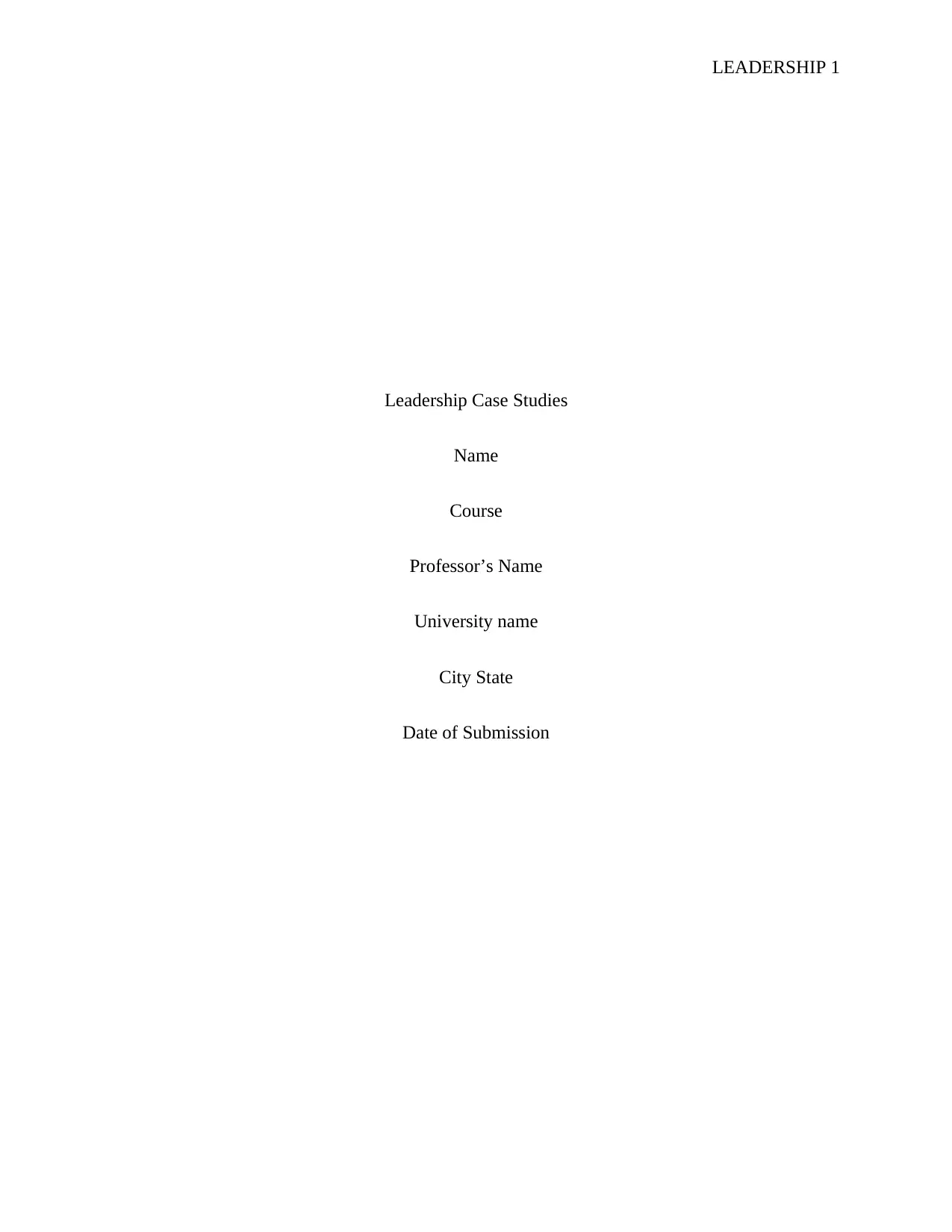
LEADERSHIP 1
Leadership Case Studies
Name
Course
Professor’s Name
University name
City State
Date of Submission
Leadership Case Studies
Name
Course
Professor’s Name
University name
City State
Date of Submission
Paraphrase This Document
Need a fresh take? Get an instant paraphrase of this document with our AI Paraphraser
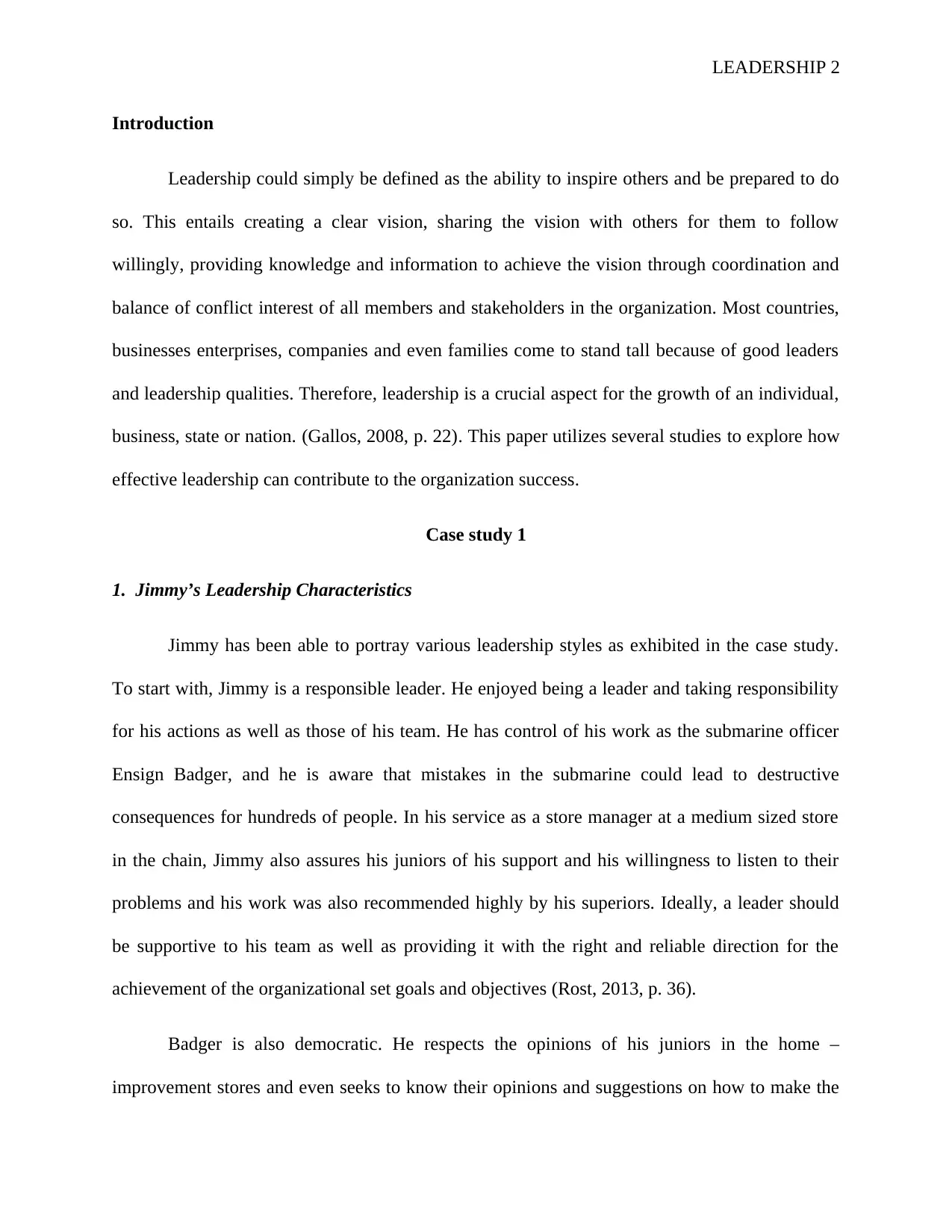
LEADERSHIP 2
Introduction
Leadership could simply be defined as the ability to inspire others and be prepared to do
so. This entails creating a clear vision, sharing the vision with others for them to follow
willingly, providing knowledge and information to achieve the vision through coordination and
balance of conflict interest of all members and stakeholders in the organization. Most countries,
businesses enterprises, companies and even families come to stand tall because of good leaders
and leadership qualities. Therefore, leadership is a crucial aspect for the growth of an individual,
business, state or nation. (Gallos, 2008, p. 22). This paper utilizes several studies to explore how
effective leadership can contribute to the organization success.
Case study 1
1. Jimmy’s Leadership Characteristics
Jimmy has been able to portray various leadership styles as exhibited in the case study.
To start with, Jimmy is a responsible leader. He enjoyed being a leader and taking responsibility
for his actions as well as those of his team. He has control of his work as the submarine officer
Ensign Badger, and he is aware that mistakes in the submarine could lead to destructive
consequences for hundreds of people. In his service as a store manager at a medium sized store
in the chain, Jimmy also assures his juniors of his support and his willingness to listen to their
problems and his work was also recommended highly by his superiors. Ideally, a leader should
be supportive to his team as well as providing it with the right and reliable direction for the
achievement of the organizational set goals and objectives (Rost, 2013, p. 36).
Badger is also democratic. He respects the opinions of his juniors in the home –
improvement stores and even seeks to know their opinions and suggestions on how to make the
Introduction
Leadership could simply be defined as the ability to inspire others and be prepared to do
so. This entails creating a clear vision, sharing the vision with others for them to follow
willingly, providing knowledge and information to achieve the vision through coordination and
balance of conflict interest of all members and stakeholders in the organization. Most countries,
businesses enterprises, companies and even families come to stand tall because of good leaders
and leadership qualities. Therefore, leadership is a crucial aspect for the growth of an individual,
business, state or nation. (Gallos, 2008, p. 22). This paper utilizes several studies to explore how
effective leadership can contribute to the organization success.
Case study 1
1. Jimmy’s Leadership Characteristics
Jimmy has been able to portray various leadership styles as exhibited in the case study.
To start with, Jimmy is a responsible leader. He enjoyed being a leader and taking responsibility
for his actions as well as those of his team. He has control of his work as the submarine officer
Ensign Badger, and he is aware that mistakes in the submarine could lead to destructive
consequences for hundreds of people. In his service as a store manager at a medium sized store
in the chain, Jimmy also assures his juniors of his support and his willingness to listen to their
problems and his work was also recommended highly by his superiors. Ideally, a leader should
be supportive to his team as well as providing it with the right and reliable direction for the
achievement of the organizational set goals and objectives (Rost, 2013, p. 36).
Badger is also democratic. He respects the opinions of his juniors in the home –
improvement stores and even seeks to know their opinions and suggestions on how to make the
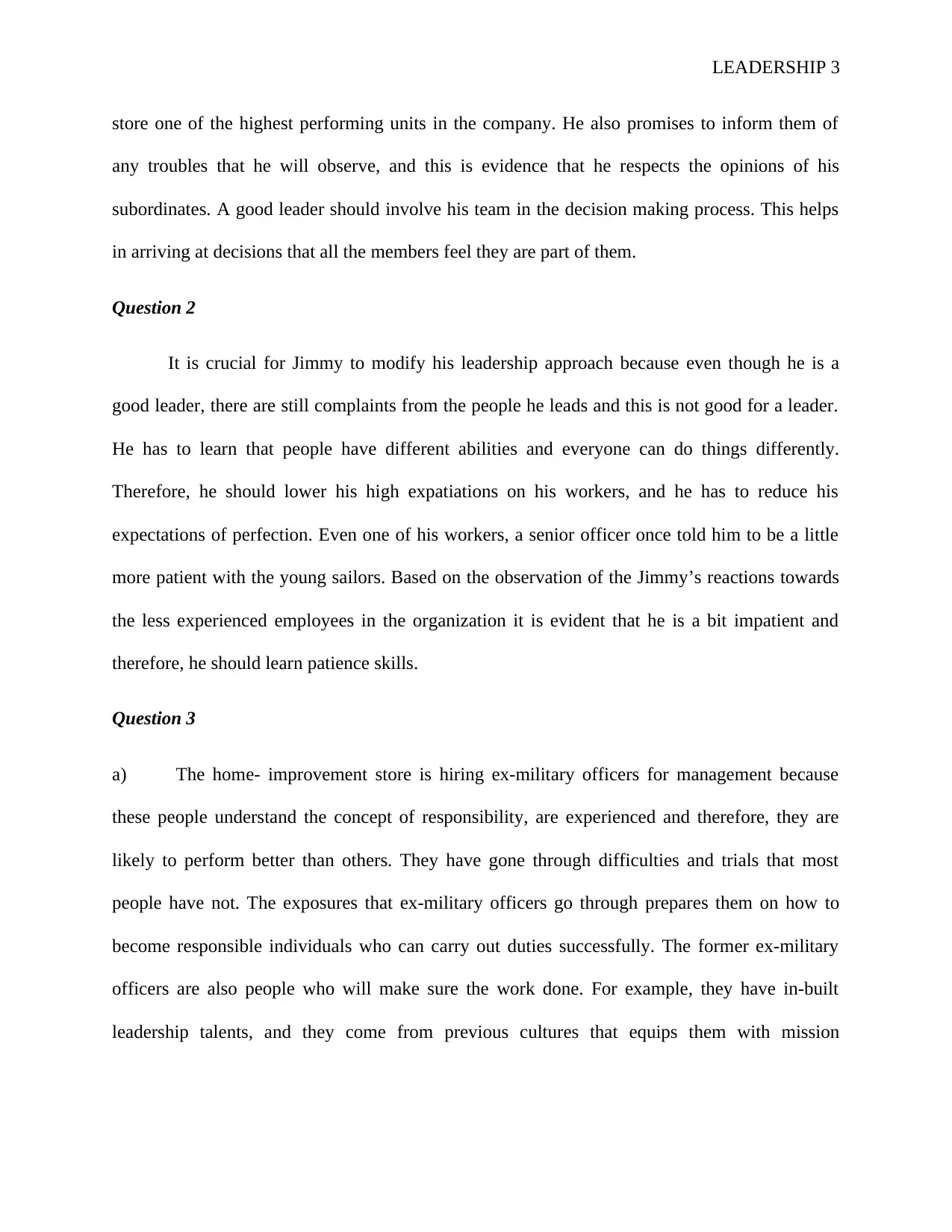
LEADERSHIP 3
store one of the highest performing units in the company. He also promises to inform them of
any troubles that he will observe, and this is evidence that he respects the opinions of his
subordinates. A good leader should involve his team in the decision making process. This helps
in arriving at decisions that all the members feel they are part of them.
Question 2
It is crucial for Jimmy to modify his leadership approach because even though he is a
good leader, there are still complaints from the people he leads and this is not good for a leader.
He has to learn that people have different abilities and everyone can do things differently.
Therefore, he should lower his high expatiations on his workers, and he has to reduce his
expectations of perfection. Even one of his workers, a senior officer once told him to be a little
more patient with the young sailors. Based on the observation of the Jimmy’s reactions towards
the less experienced employees in the organization it is evident that he is a bit impatient and
therefore, he should learn patience skills.
Question 3
a) The home- improvement store is hiring ex-military officers for management because
these people understand the concept of responsibility, are experienced and therefore, they are
likely to perform better than others. They have gone through difficulties and trials that most
people have not. The exposures that ex-military officers go through prepares them on how to
become responsible individuals who can carry out duties successfully. The former ex-military
officers are also people who will make sure the work done. For example, they have in-built
leadership talents, and they come from previous cultures that equips them with mission
store one of the highest performing units in the company. He also promises to inform them of
any troubles that he will observe, and this is evidence that he respects the opinions of his
subordinates. A good leader should involve his team in the decision making process. This helps
in arriving at decisions that all the members feel they are part of them.
Question 2
It is crucial for Jimmy to modify his leadership approach because even though he is a
good leader, there are still complaints from the people he leads and this is not good for a leader.
He has to learn that people have different abilities and everyone can do things differently.
Therefore, he should lower his high expatiations on his workers, and he has to reduce his
expectations of perfection. Even one of his workers, a senior officer once told him to be a little
more patient with the young sailors. Based on the observation of the Jimmy’s reactions towards
the less experienced employees in the organization it is evident that he is a bit impatient and
therefore, he should learn patience skills.
Question 3
a) The home- improvement store is hiring ex-military officers for management because
these people understand the concept of responsibility, are experienced and therefore, they are
likely to perform better than others. They have gone through difficulties and trials that most
people have not. The exposures that ex-military officers go through prepares them on how to
become responsible individuals who can carry out duties successfully. The former ex-military
officers are also people who will make sure the work done. For example, they have in-built
leadership talents, and they come from previous cultures that equips them with mission
⊘ This is a preview!⊘
Do you want full access?
Subscribe today to unlock all pages.

Trusted by 1+ million students worldwide
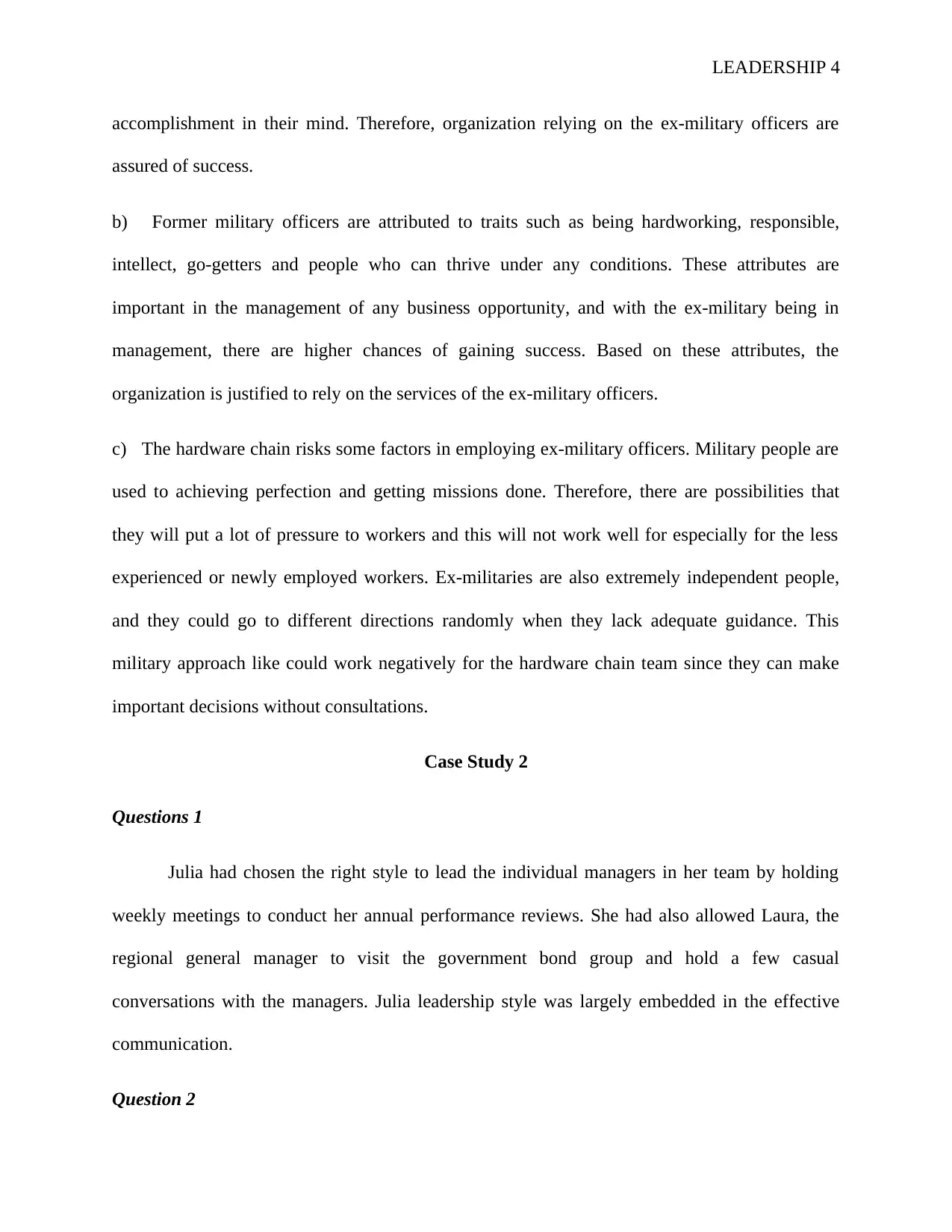
LEADERSHIP 4
accomplishment in their mind. Therefore, organization relying on the ex-military officers are
assured of success.
b) Former military officers are attributed to traits such as being hardworking, responsible,
intellect, go-getters and people who can thrive under any conditions. These attributes are
important in the management of any business opportunity, and with the ex-military being in
management, there are higher chances of gaining success. Based on these attributes, the
organization is justified to rely on the services of the ex-military officers.
c) The hardware chain risks some factors in employing ex-military officers. Military people are
used to achieving perfection and getting missions done. Therefore, there are possibilities that
they will put a lot of pressure to workers and this will not work well for especially for the less
experienced or newly employed workers. Ex-militaries are also extremely independent people,
and they could go to different directions randomly when they lack adequate guidance. This
military approach like could work negatively for the hardware chain team since they can make
important decisions without consultations.
Case Study 2
Questions 1
Julia had chosen the right style to lead the individual managers in her team by holding
weekly meetings to conduct her annual performance reviews. She had also allowed Laura, the
regional general manager to visit the government bond group and hold a few casual
conversations with the managers. Julia leadership style was largely embedded in the effective
communication.
Question 2
accomplishment in their mind. Therefore, organization relying on the ex-military officers are
assured of success.
b) Former military officers are attributed to traits such as being hardworking, responsible,
intellect, go-getters and people who can thrive under any conditions. These attributes are
important in the management of any business opportunity, and with the ex-military being in
management, there are higher chances of gaining success. Based on these attributes, the
organization is justified to rely on the services of the ex-military officers.
c) The hardware chain risks some factors in employing ex-military officers. Military people are
used to achieving perfection and getting missions done. Therefore, there are possibilities that
they will put a lot of pressure to workers and this will not work well for especially for the less
experienced or newly employed workers. Ex-militaries are also extremely independent people,
and they could go to different directions randomly when they lack adequate guidance. This
military approach like could work negatively for the hardware chain team since they can make
important decisions without consultations.
Case Study 2
Questions 1
Julia had chosen the right style to lead the individual managers in her team by holding
weekly meetings to conduct her annual performance reviews. She had also allowed Laura, the
regional general manager to visit the government bond group and hold a few casual
conversations with the managers. Julia leadership style was largely embedded in the effective
communication.
Question 2
Paraphrase This Document
Need a fresh take? Get an instant paraphrase of this document with our AI Paraphraser
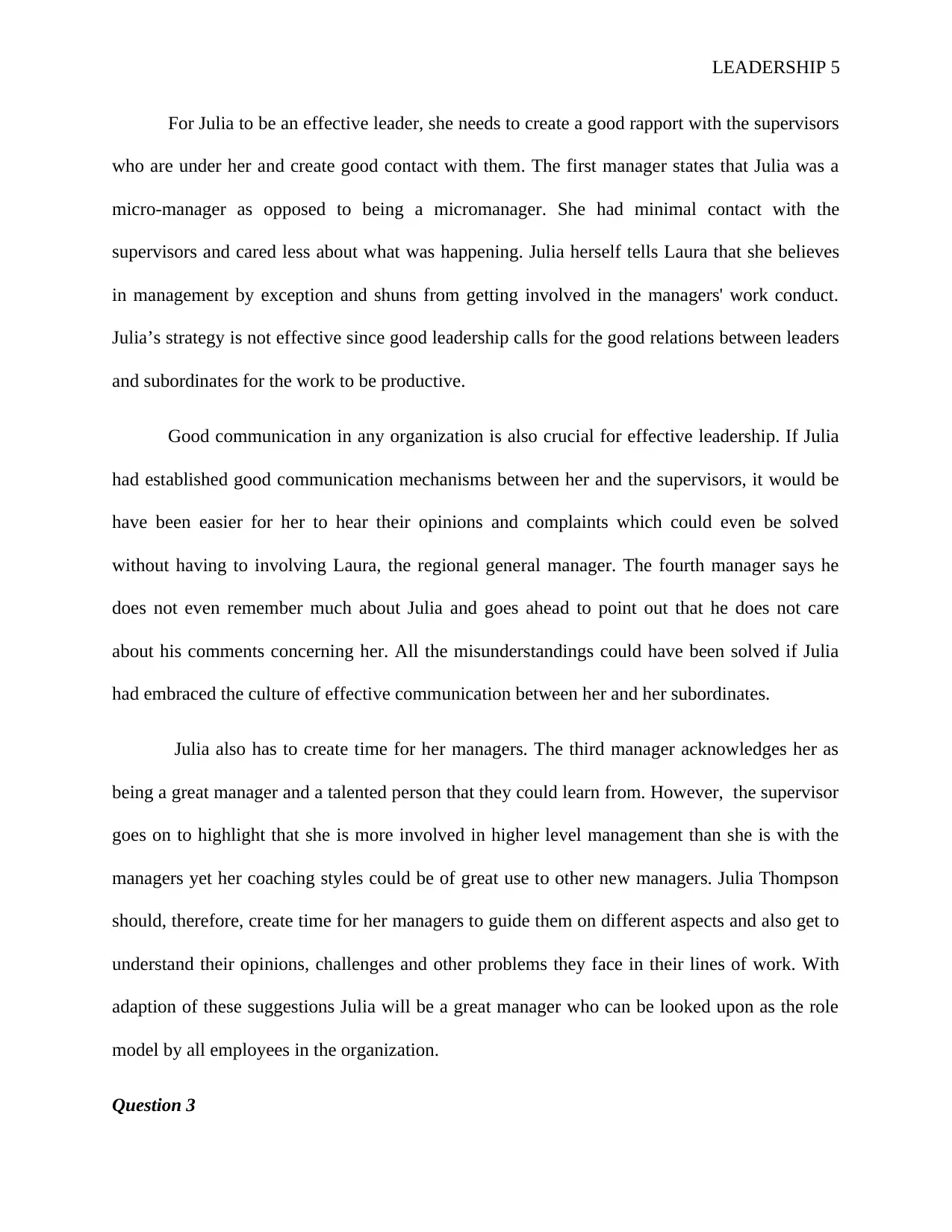
LEADERSHIP 5
For Julia to be an effective leader, she needs to create a good rapport with the supervisors
who are under her and create good contact with them. The first manager states that Julia was a
micro-manager as opposed to being a micromanager. She had minimal contact with the
supervisors and cared less about what was happening. Julia herself tells Laura that she believes
in management by exception and shuns from getting involved in the managers' work conduct.
Julia’s strategy is not effective since good leadership calls for the good relations between leaders
and subordinates for the work to be productive.
Good communication in any organization is also crucial for effective leadership. If Julia
had established good communication mechanisms between her and the supervisors, it would be
have been easier for her to hear their opinions and complaints which could even be solved
without having to involving Laura, the regional general manager. The fourth manager says he
does not even remember much about Julia and goes ahead to point out that he does not care
about his comments concerning her. All the misunderstandings could have been solved if Julia
had embraced the culture of effective communication between her and her subordinates.
Julia also has to create time for her managers. The third manager acknowledges her as
being a great manager and a talented person that they could learn from. However, the supervisor
goes on to highlight that she is more involved in higher level management than she is with the
managers yet her coaching styles could be of great use to other new managers. Julia Thompson
should, therefore, create time for her managers to guide them on different aspects and also get to
understand their opinions, challenges and other problems they face in their lines of work. With
adaption of these suggestions Julia will be a great manager who can be looked upon as the role
model by all employees in the organization.
Question 3
For Julia to be an effective leader, she needs to create a good rapport with the supervisors
who are under her and create good contact with them. The first manager states that Julia was a
micro-manager as opposed to being a micromanager. She had minimal contact with the
supervisors and cared less about what was happening. Julia herself tells Laura that she believes
in management by exception and shuns from getting involved in the managers' work conduct.
Julia’s strategy is not effective since good leadership calls for the good relations between leaders
and subordinates for the work to be productive.
Good communication in any organization is also crucial for effective leadership. If Julia
had established good communication mechanisms between her and the supervisors, it would be
have been easier for her to hear their opinions and complaints which could even be solved
without having to involving Laura, the regional general manager. The fourth manager says he
does not even remember much about Julia and goes ahead to point out that he does not care
about his comments concerning her. All the misunderstandings could have been solved if Julia
had embraced the culture of effective communication between her and her subordinates.
Julia also has to create time for her managers. The third manager acknowledges her as
being a great manager and a talented person that they could learn from. However, the supervisor
goes on to highlight that she is more involved in higher level management than she is with the
managers yet her coaching styles could be of great use to other new managers. Julia Thompson
should, therefore, create time for her managers to guide them on different aspects and also get to
understand their opinions, challenges and other problems they face in their lines of work. With
adaption of these suggestions Julia will be a great manager who can be looked upon as the role
model by all employees in the organization.
Question 3
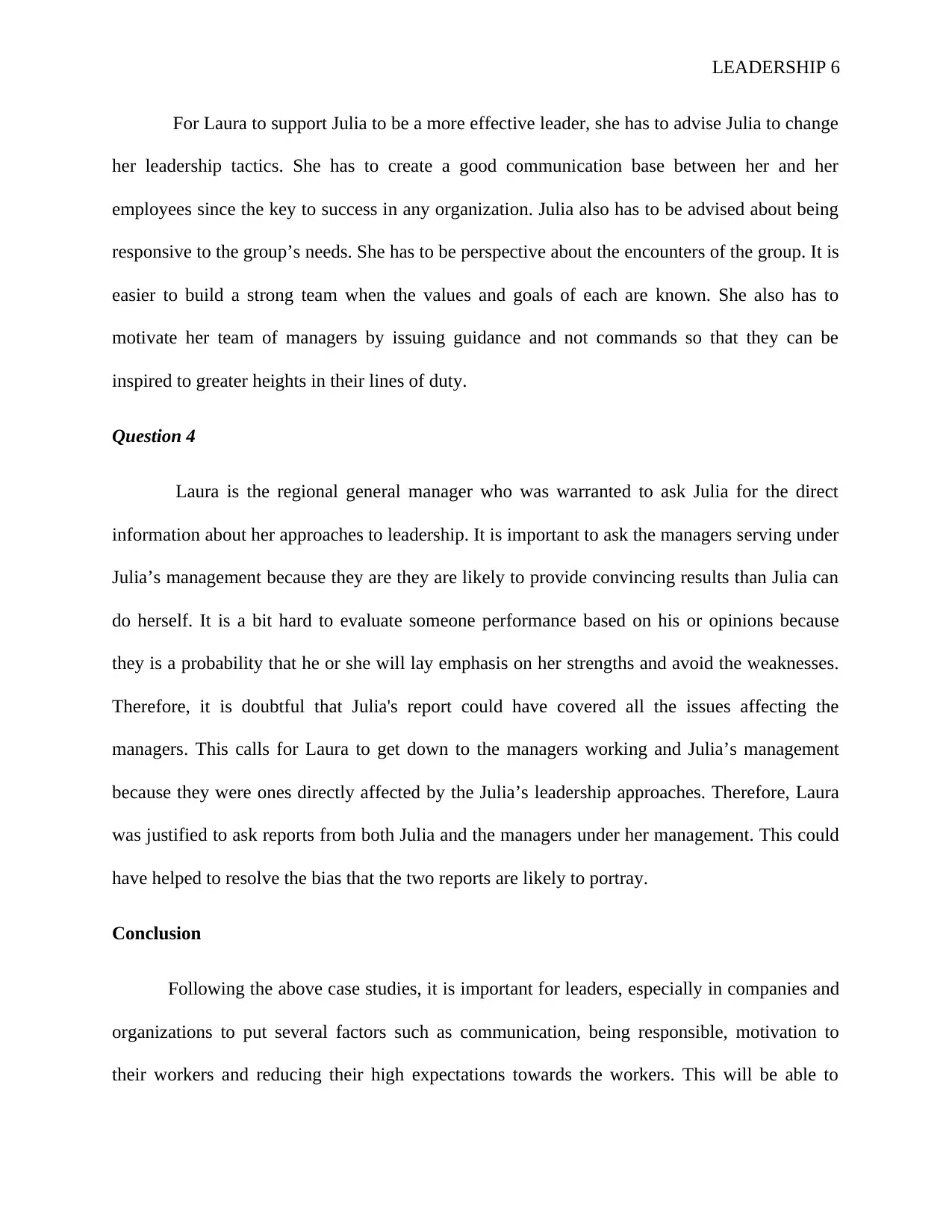
LEADERSHIP 6
For Laura to support Julia to be a more effective leader, she has to advise Julia to change
her leadership tactics. She has to create a good communication base between her and her
employees since the key to success in any organization. Julia also has to be advised about being
responsive to the group’s needs. She has to be perspective about the encounters of the group. It is
easier to build a strong team when the values and goals of each are known. She also has to
motivate her team of managers by issuing guidance and not commands so that they can be
inspired to greater heights in their lines of duty.
Question 4
Laura is the regional general manager who was warranted to ask Julia for the direct
information about her approaches to leadership. It is important to ask the managers serving under
Julia’s management because they are they are likely to provide convincing results than Julia can
do herself. It is a bit hard to evaluate someone performance based on his or opinions because
they is a probability that he or she will lay emphasis on her strengths and avoid the weaknesses.
Therefore, it is doubtful that Julia's report could have covered all the issues affecting the
managers. This calls for Laura to get down to the managers working and Julia’s management
because they were ones directly affected by the Julia’s leadership approaches. Therefore, Laura
was justified to ask reports from both Julia and the managers under her management. This could
have helped to resolve the bias that the two reports are likely to portray.
Conclusion
Following the above case studies, it is important for leaders, especially in companies and
organizations to put several factors such as communication, being responsible, motivation to
their workers and reducing their high expectations towards the workers. This will be able to
For Laura to support Julia to be a more effective leader, she has to advise Julia to change
her leadership tactics. She has to create a good communication base between her and her
employees since the key to success in any organization. Julia also has to be advised about being
responsive to the group’s needs. She has to be perspective about the encounters of the group. It is
easier to build a strong team when the values and goals of each are known. She also has to
motivate her team of managers by issuing guidance and not commands so that they can be
inspired to greater heights in their lines of duty.
Question 4
Laura is the regional general manager who was warranted to ask Julia for the direct
information about her approaches to leadership. It is important to ask the managers serving under
Julia’s management because they are they are likely to provide convincing results than Julia can
do herself. It is a bit hard to evaluate someone performance based on his or opinions because
they is a probability that he or she will lay emphasis on her strengths and avoid the weaknesses.
Therefore, it is doubtful that Julia's report could have covered all the issues affecting the
managers. This calls for Laura to get down to the managers working and Julia’s management
because they were ones directly affected by the Julia’s leadership approaches. Therefore, Laura
was justified to ask reports from both Julia and the managers under her management. This could
have helped to resolve the bias that the two reports are likely to portray.
Conclusion
Following the above case studies, it is important for leaders, especially in companies and
organizations to put several factors such as communication, being responsible, motivation to
their workers and reducing their high expectations towards the workers. This will be able to
⊘ This is a preview!⊘
Do you want full access?
Subscribe today to unlock all pages.

Trusted by 1+ million students worldwide
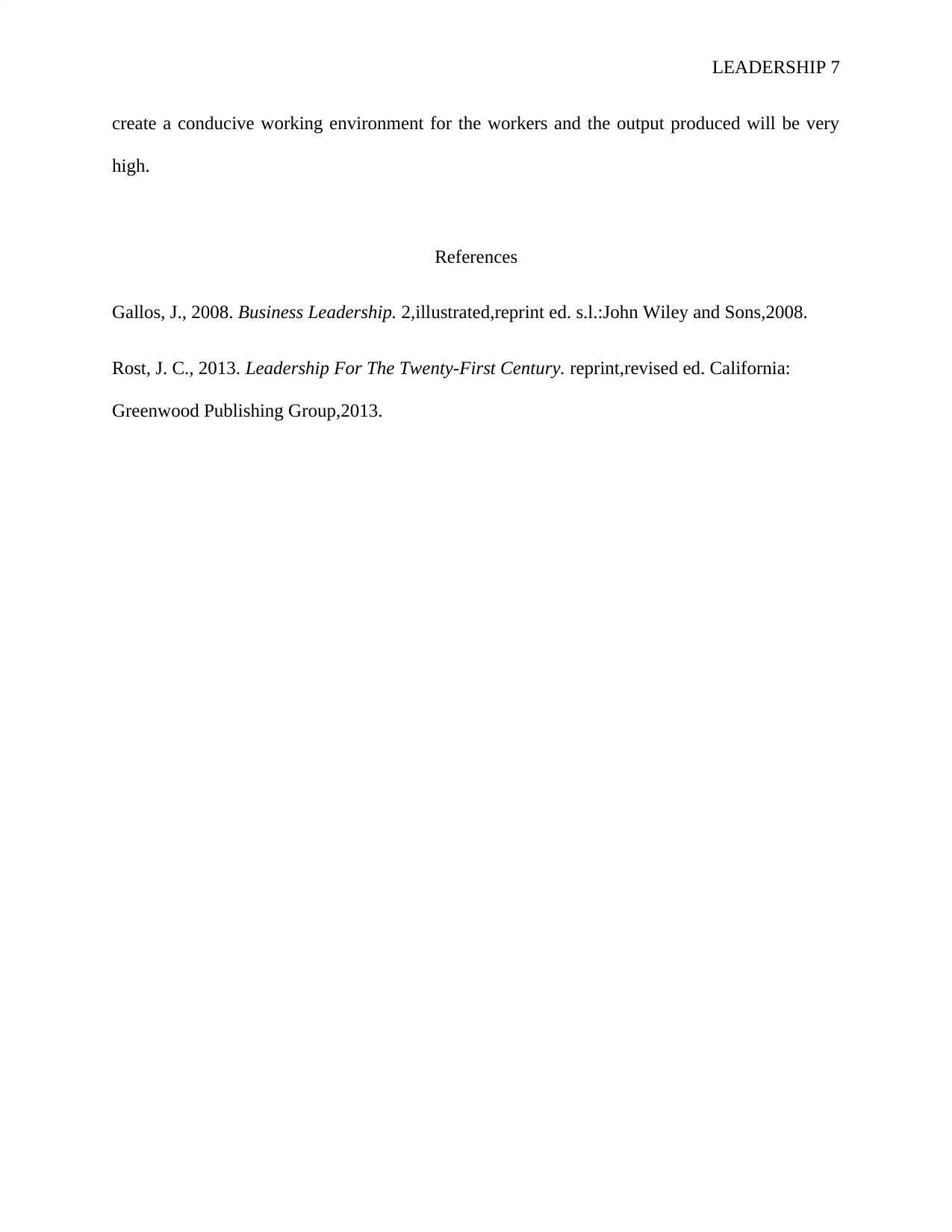
LEADERSHIP 7
create a conducive working environment for the workers and the output produced will be very
high.
References
Gallos, J., 2008. Business Leadership. 2,illustrated,reprint ed. s.l.:John Wiley and Sons,2008.
Rost, J. C., 2013. Leadership For The Twenty-First Century. reprint,revised ed. California:
Greenwood Publishing Group,2013.
create a conducive working environment for the workers and the output produced will be very
high.
References
Gallos, J., 2008. Business Leadership. 2,illustrated,reprint ed. s.l.:John Wiley and Sons,2008.
Rost, J. C., 2013. Leadership For The Twenty-First Century. reprint,revised ed. California:
Greenwood Publishing Group,2013.
1 out of 7
Related Documents
Your All-in-One AI-Powered Toolkit for Academic Success.
+13062052269
info@desklib.com
Available 24*7 on WhatsApp / Email
![[object Object]](/_next/static/media/star-bottom.7253800d.svg)
Unlock your academic potential
Copyright © 2020–2025 A2Z Services. All Rights Reserved. Developed and managed by ZUCOL.




